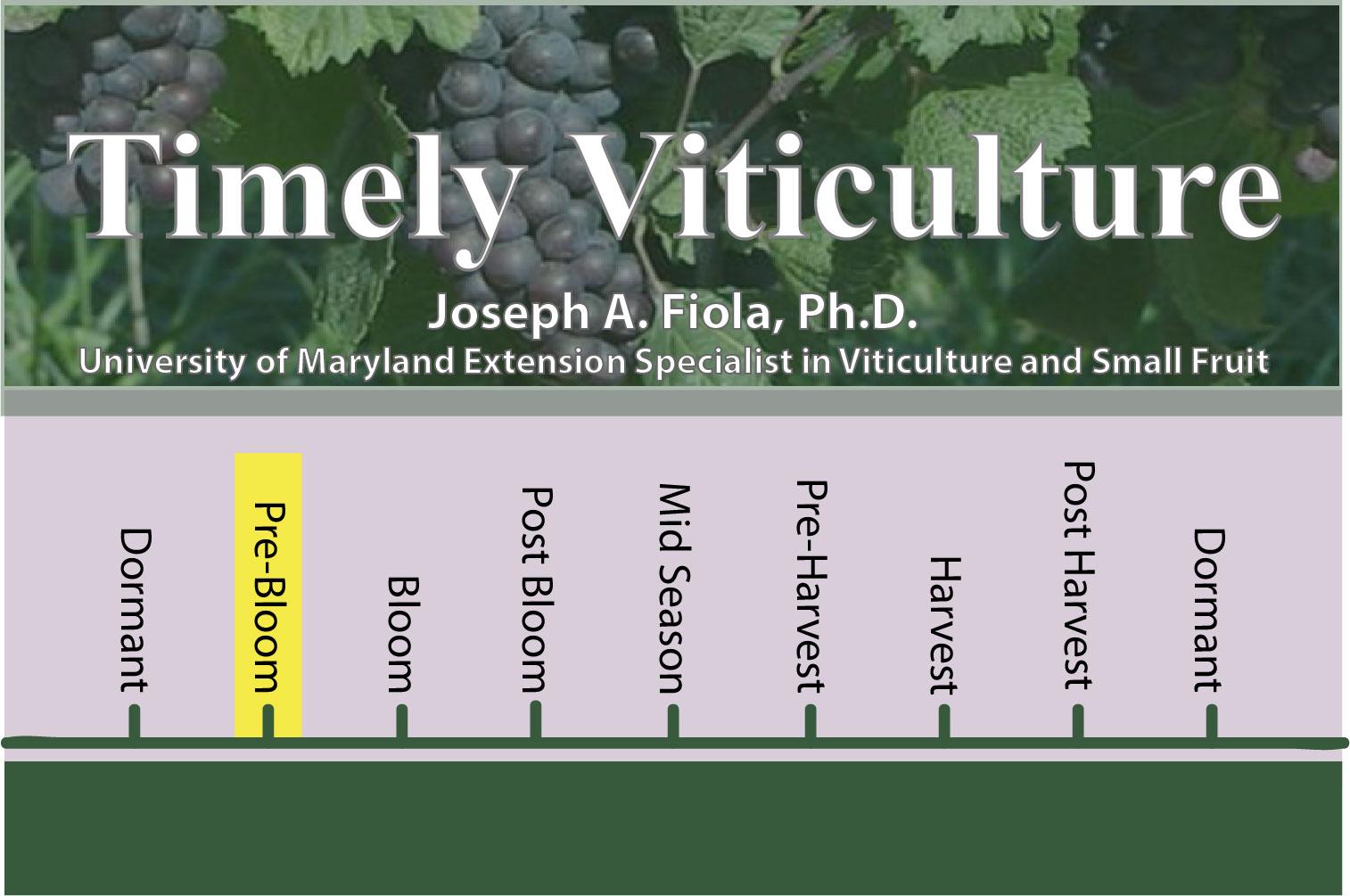Early-Season Disease Management
Growers should apply a series of protectant fungicide sprays to new shoots to protect them from several
diseases, beginning shortly after bud break. Maryland growers may refer to Extension Fact Sheet 848,
Guidelines for Developing an Effective Fungicide Spray Program for Wine Grapes in Maryland for
specific management recommendations.
½ to 1-inch Shoots
- Phomopsis cane and leaf spot is usually the earliest disease threat. Spores can germinate as soon as temperatures are above freezing, so include protection such as in your first shoot spray. Cool and wet conditions favor spore production and shoot and leaf infection.
- Powdery mildew (PM). In Maryland, the ascospores that cause primary infections on shoots and rachises may be present as soon as bud break. Extended moisture triggers ascospore released from over-wintering chasmothecia, and temperatures above 59° F, high humidity, and overcast skies favor infection. Protecting new growth from primary infections on shoots and rachises is the key to preventing later fruit infections.
- Downy mildew (DM). DM is one of the most significant issues in many vineyards. The initial inoculum (oospores) becomes active when wet soils combined with temperatures above 10ºC (50ºF), which enters stoma of tissue for infection. 0.05 inch of rain in a 24-hr period can satisfy the requirement of soil wetness.
- Black rot (BR). You may want to include BR protection in the first spray in warmer parts of the state, particularly in wet weather and in vineyards that had high levels of disease last year. Leaf infections may occur at temperatures as low as 50° F if leaves remain wet for 24 hours or longer. The warmer the temperature, the shorter the leaf wetness period needed for infection. If you are using mancozeb or captan for Phomopsis and DM, they will protect against BR as well.
Mancozeb is typically recommended for the first shoot spray, due to its efficacy against the majority of early-season diseases including Phomopsis, DM, BR and Anthracnose (Bird’s-eye rot). Unless relatively high PM pressure is expected (i.e. a concern in the previous season), PM may not need to be covered with the 1st spray. Otherwise, sulfur is a good and inexpensive option than can be tank-mixed with Mancozeb.
3 to 5-inch Shoots
- Continue protection for Phomopsis, PM and DM. Begin protection for BR if you didn’t do so at the first shoot spray. Preventing leaf lesions reduces BR inoculum for fruit infections.
- Make your second shoot spray 7–10 days after the first spray. If 2 or more inches of rain have fallen since the first spray, or if shoots are growing rapidly. Protectant fungicides must be re-applied as new growth occurs, as they do not move systemically to protect it.
- If rain is predicted between 7 and 10 days after the first spray, make the second spray before the rain. Some studies have shown 1-inch of rain could wash-off as much as 60 percent of the protectant fungicide residue. However, there is a great variability among fungicides and formulations in their ability to adhere to plant surfaces. Systemic fungicides therefore are better choices during rainy days.
6 to 10-inch Shoots
- Continue protection for Phomopsis, PM, DM and BR. Make your third spray 7–10 days after the second spray. See the note on intervals under the previous spray.
- If you are using a fungicide that is at high or medium risk of resistance development, it is wise to tank-mix with a low-risk fungicide if resistance issues at your site are unknown. Limit total applications of these fungicides to no more than 2 per season. See Table 2 of Fact Sheet 848 for more information on fungicide classes and resistance risks.
- Bear in mind that resistance to FRAC 11 (e.g. Pristine) and FRAC 40 (e.g. Revus) fungicides has been detected to DM pathogen in the region, minimizing the use of these chemical classes if possible.
12 to 17-inch Shoots
- Continue protection for DM, PM, and BR. In addition, anthracnose may need to be covered if it has been an issue in the past.
- If you have been using paraffinic oil (JMS Stylet-Oil or Pure-Spray) for PM, switch to another fungicide after the last shoot spray. Later in the season, oil can slow growth and retard fruit ripening.
- Remember to increase spray volume as the canopy fills out to ensure thorough coverage.
For more information, contact Dr. Mengjun Hu at mjhu@umd.edu or Dr. Joseph A. Fiola at jfiola@umd.edu.
Thanks to Anne DeMarsay, Ph.D., (former University of Maryland Extension Specialist in Fruit Pathology) for the original version of this TimelyVit.
Timely Viticulture is designed to give those in the Maryland grape industry a timely reminder on procedures or topics they should be considering in the vineyard.
